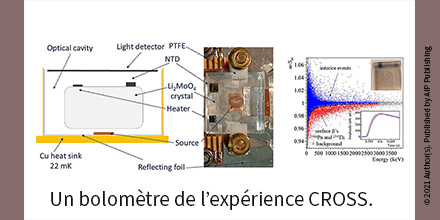
As part of the CROSS project (Cryogenic Rare-event Observatory with Surface Sensitivity), funded by a European ERC Advanced Grant, the ASSD group of the A2C Pole, in collaboration with the Cryogenic Detectors Service of the Detectors and Instrumentation Department, developed at IJCLab a phonon-mediated particle detector with unprecedented sensitivity to surface events. The detector is based on a lithium molybdate single crystal and operates at temperatures of the order of 20mK.
In general, this type of device is not sensitive to the point of impact of the particle, especially if the detection is done through thermal phonons. The ASSD group was able to distinguish the radioactivity (β and α) which occurs on the surface of the crystal from that which takes place inside the crystal by covering the face of the crystal with a thin metallic film. The coating affects the phonon decay cascade that follows the interaction of the particles, so that events occurring near the film have a shape-altered signal. Surface radioactive events are the dominant background noise in bolometric experiments looking for double beta decay without neutrino emissions.
Efficient identification of surface events has been demonstrated with detectors based on a 20×20×10mm3 rectangular crystal coated with a normal Pd metal film (10nm thick) and Al-Pd superconducting bilayers. (100nm-10nm thick) on a 20×20mm2 face. The β and α surface events are identified for energy deposits down to depths of the order of a millimeter. The entire development, from detector design to manufacturing and experimental study, was carried out at IJCLab.This technology could substantially improve the sensitivity of experiments looking for the double beta decay of the promising 100MB isotope, which would pave the way for the discovery of Majorana neutrinos.
See AIP Scilight
See also : AIP-Applied Physics Letters
Astroparticles, Astrophysics and Cosmology























